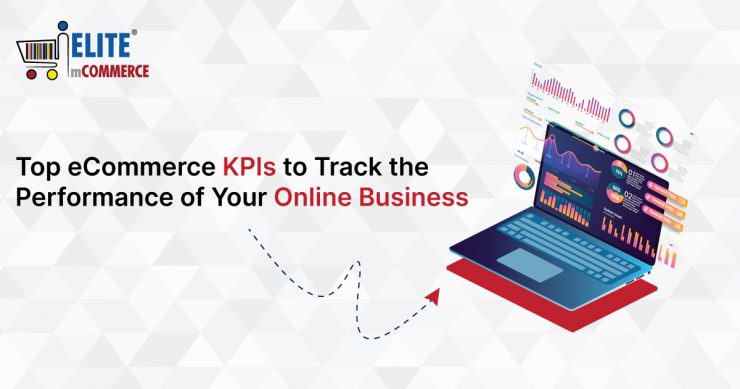In a layperson’s language, Key Performance Indicators (KPIs) are metrics through which can measure the performance of an eCommerce enterprise. These KPIs can help online retailers evaluate their performance, set benchmarks, introspect, make better business decisions and venture out on a journey of corrective efforts. Simply put, eCommerce KPIs are the anchor steering a business to the right direction.
Importance of eCommerce KPIs: A Crisp Overview
To begin with, eCommerce KPIs and metrics are crucial, as they help a business gauge their performance and track to see if their daily operations are facilitating the overarching organizational goals. Besides, eCommerce metrics are also used by businesses to analyze data and gain more insights into the company functions. Furthermore, KPIs enable a retailer to get a bird’s eye view of their business strategy and set things straight, accordingly. However, most importantly, the data analyzed by setting up eCommerce KPIs can be used to educate the sales and operations team of a company and improve the overall performance.
Nowadays, there is a plethora of eCommerce KPIs, but the right KPIs for your business share the following attributes –
- They must be impactful
- They must be accurately measurable
- They ought to be actionable to facilitate improvements
- They must deliver data in real-time
Now that we have touched upon the basics of eCommerce KPIs, let us look at the top metrics that your online business mist track for success, profitability, and improved decision-making.
Top Seven eCommerce KPIs Worthy of Tracking in 2023
- Sell-through Rate
In simple words, we can understand the sell-through rate as the KPI that measures the amount of inventory your online business has sold within a stipulated time period vis-à-vis the amount of inventory actually received within the same period. The formula to calculate the sell-through rate is – Sell-through Rate = Number of units sold/number of units received x 100
The pertinent benefits of tracking sell-through rates are –
- Improved pricing decisions
- You can dodge the risk of your inventory becoming obsolete
- You can properly plan the supply and production process
2. Shopping Cart Abandonment Rate
The Shopping Cart Abandonment Rate is a KPI that denotes how many shoppers add items into their shopping carts but leave empty-handed before exiting your website. Online business owners must analyze their shopping cart abandonment rate to –
- Understand the shopping behavior of your target customers and the frequent visitors of your website
- Analyze how intuitive and dependable your website’s checkout process is
- Examine the reasons why your customers will not convert
- The formula to calculate the shopping cart abandonment rate is –
- Shopping Cart Abandonment Rate = 1-(Total Number of Purchases)/(Number of Shopping Carts Created) x 100
Read also: Benefits of Virtual Marketplace development with Augmented & Virtual Reality
3. Conversion Rate
The third very important eCommerce KPI is the conversion rate, which measures the total number of visitors on your product listing or online store that made a purchase, that is, converted. It is imperative for eCommerce ventures to track conversion rates, as they help investigate the shopping behavior of casual visitors and customers and assess the reasons why some consumers do not convert. The formula to calculate the conversion rate is – Conversion Rate = Total number of Conversions/Total Number of Leads x 100
4. Return Rate
Return Rate is an eCommerce KPI that can be understood as the frequency by which a customer returns their online orders. It is a crucial metric to understand and improve customer satisfaction and revenue. You can calculate the return rate with the following formula – Return Rate = (Total Number of Returns/Total Number of Items) Sold x 100
Some of the veritable benefits of tracking eCommerce return rates are –
- You get an accurate measurement of customer satisfaction
- You understand the reasons that culminate in returns
- You can corrective measures to minimize returns
- Retain revenue
5. Inventory Turnover
The fifth eCommerce KPI – inventory turnover – is used to measure the number of times the inventory is completely sold out in a given time period. Having a grasp on inventory turnover helps online business owners transform their inventory into sales. Besides, some of the other advantages of tracking inventory turnover rates are –
- You can recognize in how much inventory is sold over a stipulated time frame
- You can analyze the blockage of working capital
- Dodge’s high maintenance and carrying costs
- Predict and manage accurate inventory levels
- Implement an effective sales plan
- Assess the risk of the inventory becoming obsolete or expired
You can calculate the inventory turnover rate with the following formula – Inventory Turnover = Cost of Goods Sold/Average Inventory
6. Average Order Value (AOV)
Average Order Value or AOV is a KPI that measures the average amount of money your online business spends each time a customer places an order on your website or other third-party platforms. You can calculate the Average Order Value (AOV) with the following formula – Average Order Value = Total Revenue/Number of Orders
Some of the reasons why tracking AOV is indispensable for eCommerce ventures are –
- You understand the purchase patterns and trends of online shoppers
- You can choose the right pricing strategy
- You can quantify revenues and profits
7. Gross Profit Margin
Lastly, the gross profit margin is an eCommerce KPI that you can use to assess your enterprise’s financial wellbeing by measuring the amount of money left over from the product sales after deducting the cost of goods sold (COGS). It is crucial for eCommerce brands to keep track of the gross profit margin so that they can understand the profitability of the business, adjust the pricing strategy and reduce expenses.
You can calculate the gross profit margin by using the following formula – Gross Profit Margin = Revenue – COGS/Revenue
Wrapping It Up
So, there we have it, a crisp overview of the seven most important eCommerce KPIs that every business must track. Besides the ones mentioned above, some other pivotal KPIs include customer lifetime value (CLV), order accuracy rate, customer acquisition cost (CAC), and so forth. If you want your online business to stand out and stay afloat, consider tracking KPIs in an efficient and timely manner.









Add comment